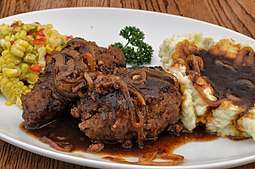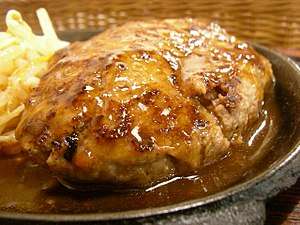Salisbury steak
Salisbury steak is a dish, originating in the United States, made from a blend of ground beef and other ingredients and usually served with gravy or brown sauce. It is a version of Hamburg steak.
 Salisbury steak with brown gravy | |
| Course | Entrée |
|---|---|
| Place of origin | United States |
| Created by | J. H. Salisbury |
| Serving temperature | Hot |
| Main ingredients | Ground beef |
| Ingredients generally used | Various |
| Similar dishes | Hamburger |
History

Minced meat was a delicacy in medieval cuisine, red meat usually being restricted to the higher classes.[1] Very little mincing was done by medieval butchers or recorded in the cookbooks of the time, perhaps because it was not part of the sausage-making process that preserves meat. Russian ships brought recipes for steak tartare to the port of Hamburg during the 17th century,[2] a time when there was such a great presence of Russian residents there that it was nicknamed "the Russian port". Trade within the Hanseatic League between the 13th and 17th centuries made this port one of the largest in Europe, its commercial importance being further heightened as it became vital to early transatlantic voyages during the age of steam. In the period of European colonization of the Americas, immigrants to this port were a "bridge" between old European recipes and the future development of the hamburger in the United States.[3]
During the first half of the 19th century, most of the northern European emigrants who traveled to the New World embarked on their transatlantic voyages from Hamburg. The German shipping company Hamburg America Line, also known as the Hamburg Amerikanische Packetfahrt Aktien-Gesellschaft (HAPAG), was involved in Atlantic transport for almost a century.[4] The company began operations in 1847 and employed many German immigrants, many of them fleeing the revolutions of 1848–49. New York City was the most common destination for ships traveling from Hamburg, and various restaurants in the city began offering the Hamburg-style steak in order to attract German sailors. The steak frequently appeared on the menu as a Hamburg-style American fillet,[5][6] or even beefsteak à Hambourgeoise. Early American preparations of minced beef were therefore made to fit the tastes of European immigrants, evoking memories of the port of Hamburg and the world they left behind.[4]
Hamburg steak
In the late 19th century, Hamburg steak became popular on the menus of many restaurants in the New York area. This kind of fillet was beef minced by hand, lightly salted and often smoked, and usually served raw in a dish along with onions and bread crumbs.[7][8] The oldest document that refers to the Hamburg steak is a Delmonico's Restaurant menu from 1873 which offered customers an 11-cent plate of Hamburg steak that had been developed by American chef Charles Ranhofer (1836–1899). This price was high for the time, twice the price of a simple fillet of beef steak.[6][9] However, by the end of the century the Hamburg steak was gaining popularity because of its ease of preparation decreasing cost. This is evident from its detailed description in some of the most popular cookbooks of the day.[10] Documents show that this preparation style was used by 1887 in some U.S. restaurants and was also used for feeding patients in hospitals; the Hamburg steak was served raw or lightly cooked and was accompanied by a raw egg.[11]
The menus of many American restaurants during the 19th century included a Hamburg beefsteak that was often sold for breakfast.[12]
Salisbury steak
Coming from this history of ground meat dishes is the Salisbury steak, which today is usually served with a gravy similar in texture to brown sauce. James Salisbury (1823–1905), an American physician and chemist, advocated for a meat-centered diet to promote health, and the term Salisbury steak has been used in the United States since 1897.[13]
Dr. Salisbury recommended this recipe (somewhat different from modern Salisbury steak recipes) for the treatment of alimentation (digestive problems):
Eat the muscle pulp of lean beef made into cakes and broiled. This pulp should be as free as possible from connective or glue tissue, fat and cartilage...previous to chopping, the fat, bones, tendons and fasciae should all be cut away, and the lean muscle cut up in pieces an inch or two square. Steaks cut through the centre of the round are the richest and best for this purpose. Beef should be procured from well fatted animals that are from four to six years old.
The pulp should not be pressed too firmly together before broiling, or it will taste livery. Simply press it sufficiently to hold it together. Make the cakes from half an inch to an inch thick. Broil slowly and moderately well over a fire free from blaze and smoke. When cooked, put it on a hot plate and season to taste with butter, pepper, salt; also use either Worcestershire or Halford sauce, mustard, horseradish or lemon juice on the meat if desired. Celery may be moderately used as a relish.[14]
U.S. standards of identity (for packaged product)
United States Department of Agriculture standards[15] for processed, packaged "Salisbury steak" require a minimum content of 65% meat, of which up to 25% can be pork, except if de-fatted beef or pork is used, the limit is 12% combined. No more than 30% may be fat. Meat byproducts are not permitted; however, beef heart meat is allowed. Extender (bread crumbs, flour, oat flakes, etc.) content is limited to 12%, except isolated soy protein at 6.8% is considered equivalent to 12% of the others. The remainder consists of seasonings, fungi or vegetables (onion, bell pepper, mushroom or the like), binders (can include egg) and liquids (such as water, milk, cream, skim milk, buttermilk, brine, vinegar etc.). The product must be fully cooked, or else labeled "Patties for Salisbury Steak".
References
- Alan Beardsworth, Teresa Keil, (1997), "Sociology on the Menu: An Invitation to the Study of Food and Society", Ed. Routledge
- Clapp, Edwin J. (1952). The Port of Hamburg (1st ed.). Yale University Press.
- Osborn Cummings, Richard (June 1970). The American and His Food (The Rise of urban America) (1st ed.). Ayer Co Pub. ISBN 0-405-02445-2.
- Moch, Leslie Page (2003). Moving Europeans: Migration in Western Europe Since 1650 (2nd ed.). Indiana University Press. ISBN 0-253-21595-1.
- Ranhofer, Charles (1894). The Epicurean: A Complete Treatise of Analytical & Practical Studies (1st ed.). B00085H6PE.
- Ozersky, Josh (2008). The Hamburger: A History (Icons of America) (1st ed.). London: Yale University Press. ISBN 0-300-11758-2.
- 1802, "Oxford English Dictionary"
- Fitzgibbon, Theodora (January 1976). The Food of the Western World: An Encyclopedia of Food from North America and Europe (1st ed.). London: Random House Inc. ISBN 0-8129-0427-3.
- Food in American History, Part 6 – Beef (Part 1): Reconstruction and Growth into the 20th Century (1865–1910), by Louis E. Grivetti, PhD, Jan L. Corlett, PhD, Bertram M. Gordon, PhD, and Cassius T. Lockett, PhD
- Farmer, Fannie Merritt (1896). Boston Cooking-School Cookbook. Gramercy (ed. 1997). ISBN 0-517-18678-0.
- Murrey, Thomas Jefferson (1887). "Eating Before Sleeping". Cookery for Invalids (PDF) (1st ed.). New York City: White Stokes & Allen. pp. 30–33. Retrieved 2013-12-24.
- Roger M. Grace, "Old Menus Tell the History of Hamburgers", Los Angeles, CA Metropolitan New-Enterprise newspaper
- "Salisbury steak". Merriam-Webster Online. Retrieved 2009-01-28.
- The Relation of Alimentation and Disease By James Henry Salisbury
- Food Standards and Labeling Policy, USDA Archived 2011-02-05 at the Wayback Machine, FSIS, September 2005, p. 165
